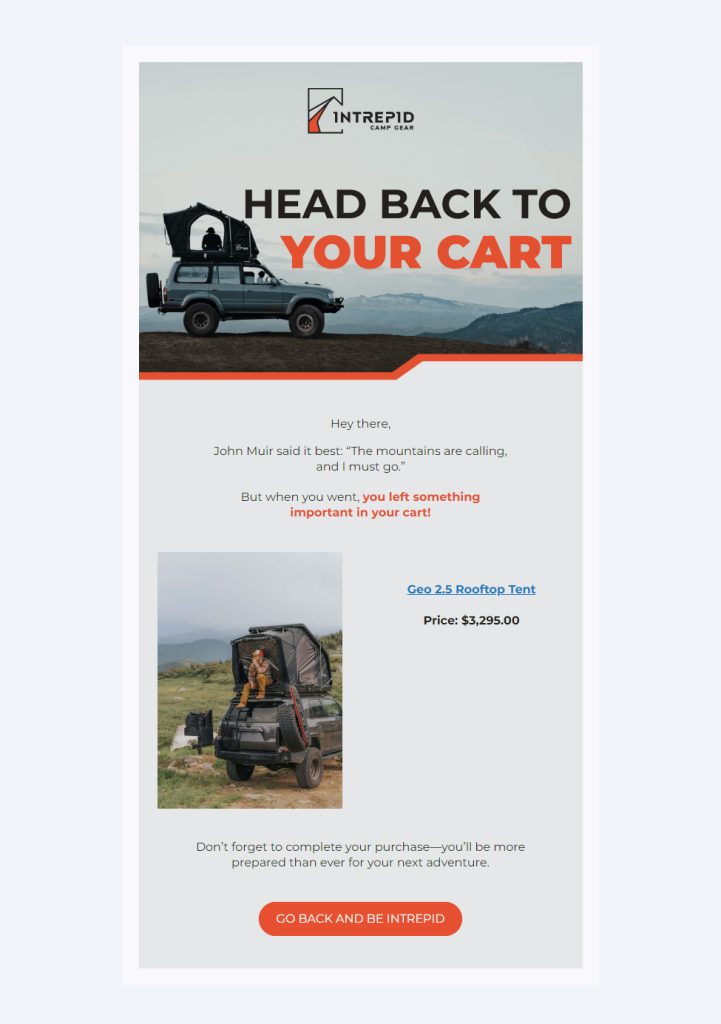To send the most relevant content to your subscribers via email, you need to understand your audience and segment your contact lists using custom contact fields or statistical data. Dynamic segmentation is key when aiming for higher engagement rates and increased open rates. Read on to discover which segments could work best for your email marketing!
Segments are dynamically generated lists of contacts. By using segmentation, you can divide your email contact lists into smaller groups based on specific conditions. This enables you to enhance your email personalization significantly. As we know, subscribers expect a personal touch from brands.
With personalized messages, users feel more valued and better recognized by the company. Not only does this result in a positive mood among users, but it also impacts sales. According to reports, companies with personalized marketing tactics can expect a 40% revenue increase. Send information relevant to your target group instead of bombarding them with irrelevant emails, and you will see the effects in no time.
Segments work best when combined with automation. Utilize automation flows to get the most out of your contacts.
In this article, we will share some segment ideas, many of which should be effective for your business. Sometimes custom contact fields will be required. Find out how to use custom contact fields in this video.
This is what an example segment will look like - this segment includes users from Canada and Poland who have opened more than 5 emails and clicked on more than 3 campaigns.
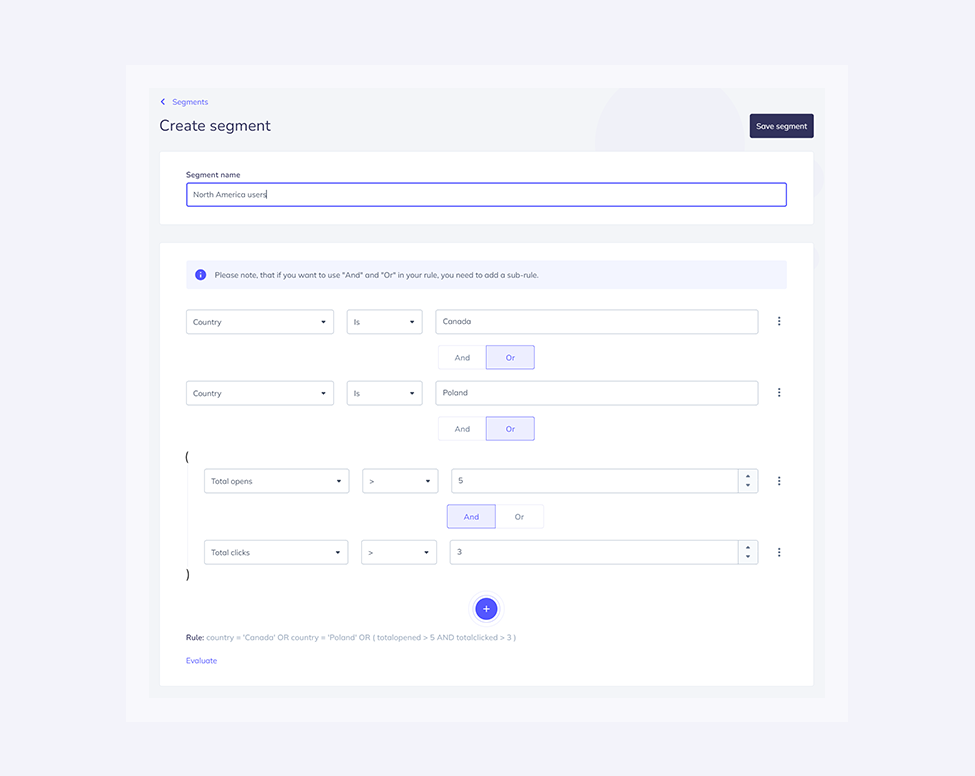
What segments will be included in this article? Let’s see:
Table of Contents
- The most engaged subscribers
- Win-back email
- Content interest as the indicator
- Upselling & cross-selling
- Abandoned cart
- Stage of the sales funnel
- Information based on a survey
- Industry
- Revenue
- Country
- Birthday
- Time-zones
- Gender
- Bargain hunters
- Didn’t purchase for a long time
- Website activity
- Specific email providers
- Summary
- Key Takeaways
The most engaged subscribers
It’s always a good idea to create a segment consisting of the most engaged customers and recipients. Every account in Elastic Email has a predefined segment called “Engaged Contacts,” based on the status "Engaged." Learn more about contact statuses here if you don’t know how they work. You can also narrow this group further and select those subscribers who are the most engaged with your communication.
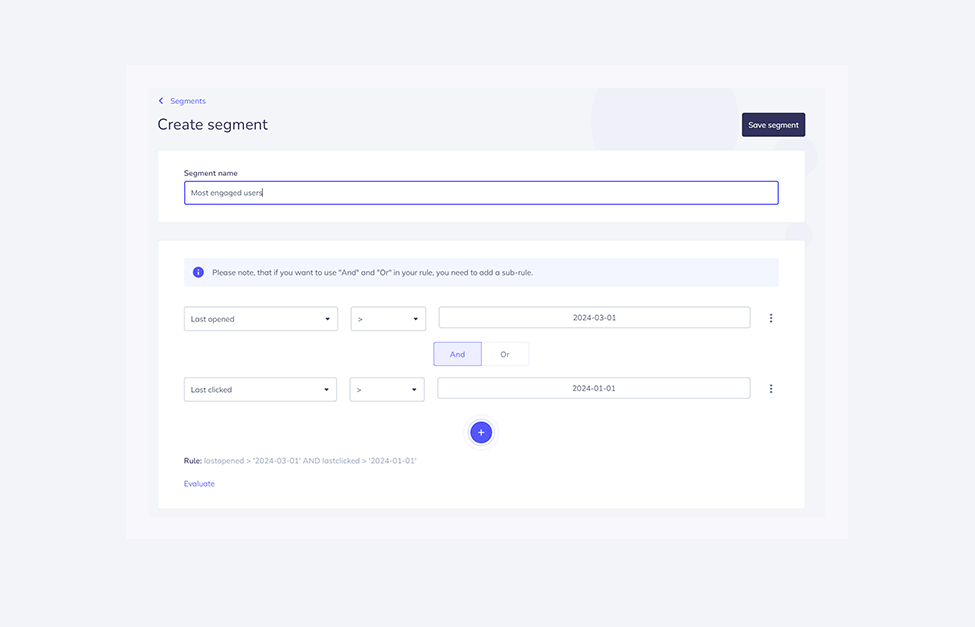
The key factor is how frequently you send campaigns. If you run several campaigns each month, consider creating a segment of recipients who opened your emails in the last two weeks. If you send campaigns less frequently, you might want to target subscribers who clicked on an email within the last three months. This engaged group can be particularly useful for warming up IPs or distributing high-season discounts, depending on your email marketing strategy.
You can gather more information by using progressive forms or by importing contact lists with additional details about your customers.
Win-back email
On the other hand, every list includes customers who haven’t interacted with our emails for longer periods. In such cases, we can launch a win-back campaign in an attempt to re-engage these users. This could mean offering special discounts or incentives to catch their attention or employing a humorous approach to reignite their interest. Below is an example of such an approach:
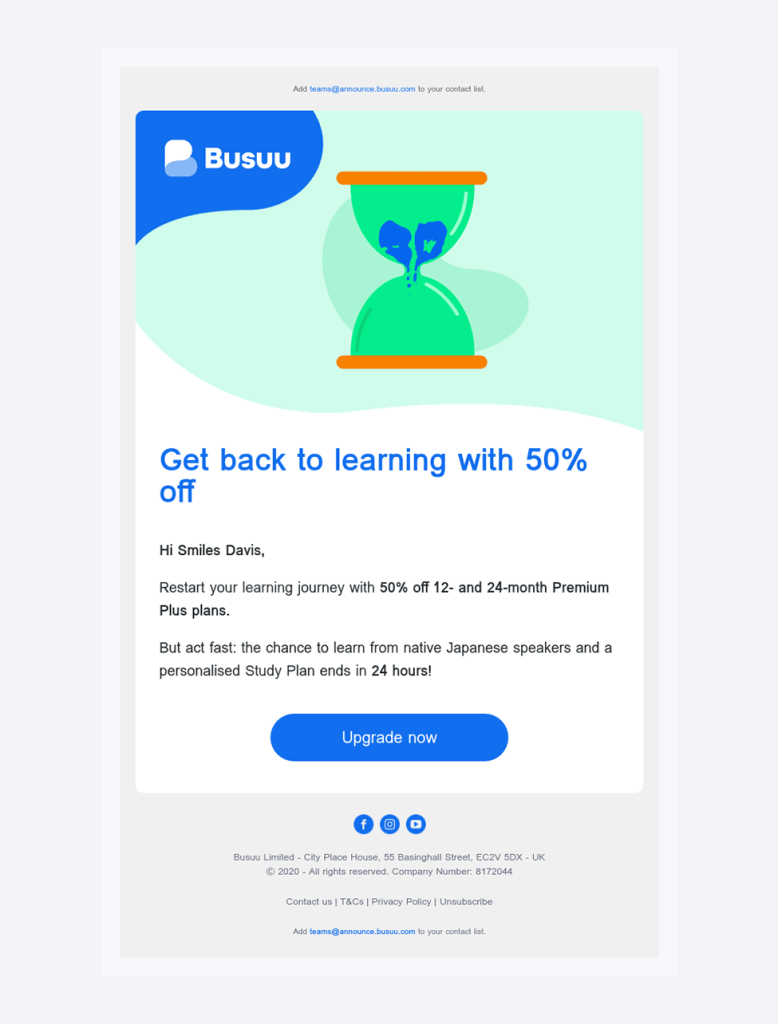
To maximize the effectiveness of this campaign, we could utilize automation to send emails to users immediately after they join the segment by API calls. Then, we could set up the automation once and simply monitor the results to see how many inactive users we were able to win back with this approach!
Unfortunately, if the attempt fails and a user doesn’t open the email, we should consider removing them from our list. Sending emails to inactive users can potentially harm our sender’s reputation, hence it's not recommended.
Content interest as the indicator
By generating numerous white papers or unique publications on the blog, we can leverage our understanding of user engagement to formulate segments. Consider a scenario where we have three core topics, such as Elastic Email - email API, email marketing, and email delivery tips. If certain users consistently engage with only one of these topics, it may not be beneficial to send them white papers on the other subjects. This method enhances engagement and communicates to users that we value their interests and involvement. For instance, if a segment shows a strong preference for topics like "essay writer not AI," it’s clear that content related to AI in writing may be less relevant to them.
Upselling & cross-selling
If you run an ecommerce business, you likely collect data about purchases. Some companies even use AI in ecommerce to analyze this data. Depending on your specific business model, there is a definite opportunity to categorize products and use this information to create new segments.
For instance, if you are selling courses related to Google Analytics 4, then there is a huge chance that, as an upselling strategy, you can also try to monetize courses connected with Google Tag Manager. These are two topics that go hand in hand, and it’s very common for users to decide to learn both. Offering supplementary products can boost your revenue.
On the other hand, you can try using upselling. Let’s say someone starts using your services but opts for the lowest available tier. There is room for product and feature marketing to highlight the advantages of upgrading their account. Through education and showcasing features, you can persuade the user to choose a more expensive plan that is more profitable for you.
Abandoned cart
Abandoned carts are a nightmare for online store owners. Why would someone add a product to the basket but not finalize the transaction? It’s hard to answer without measuring user behavior with tools like Hotjar or CUX, or checking user actions with Google Analytics 4 or Adobe Analytics. However, through email marketing, much like with ads on Google/Facebook, we can attempt to complete the purchase.
Based on website activity, we can create a segment of users who abandoned their carts last week and try to persuade them with a personalized offer or discount. Alternatively, we can simply remind them that they left something in their cart. Automation and API calls will also be helpful in handling situations like these.
Stage of the sales funnel
The sales funnel is primarily used in CRM systems, but you can also implement it within email marketing using Elastic Email. Although we don’t offer scoring as a main feature, you can create specific automation based on special triggers. For instance, if someone clicks on a link to a video related to a specific product, you can follow up with a more advanced description of it within a few days. Similarly, if someone signs up for a webinar, you can leverage this to reach the person with a specific service promotion or a free trial offer. Depending on your business, you will surely find the right usage for these segments, even with manually set up campaigns.
Information based on a survey
Running surveys and gathering data related to these activities can provide valuable insights for practical use. For example, if you have an app and aim to determine whether users are beginners or advanced specialists, you can create distinct segments based on their responses. Advanced specialists may manage account setup effortlessly, while beginners might require basic knowledge before receiving tips on advanced strategies.
Keep in mind that with custom contact fields, you can create any text, number, or boolean field you need.
Industry
If you have information about your users' industry, it would be great to use this information to create segments. Let's say you regularly release new case studies showcasing how your tool is used. It would be much more appealing for people who work in IT to receive cases related to their industry rather than reading about fashion issues. By gaining insights into the most common industries on your list, you can compare CTR or open rates between them. Use these segments to make your campaigns and content more relevant and effective.
Revenue
Segmentation based on revenue is probably the most common for SaaS or ecommerce. It doesn’t matter if you sell products or services; you should create this segment if you have information about specific user revenue. It might be the lifetime value or just the cost of a monthly subscription.
Creating different segments based on revenue quotes is a recommended strategy. This method enables tailored offers; for example, a user who spends over $1,000 monthly on your service is more eager to invest an additional $50 in a new feature than a user who spends $20 monthly. Utilizing this segmentation allows you to customize offers to fit your audience.
Country
Festivities or gross profit margins vary across different countries, so it’s logical to offer different prices in different regions. Using segmentation, you can divide your audience based on their countries.
It can be helpful not only to offer local discounts but also to celebrate significant holidays, which may have different dates, like Mother’s Day. With country segmentation, you can also personalize the language of your campaigns - for example, using Portuguese for campaigns targeting Brazil and Portugal or Spanish for audiences in Spain, Mexico, and Argentina.
Even global companies have local updates, such as new branding in a particular region, specific events, or localized promotions. This might be used in similar ways with city-based segments - for example, when opening a new restaurant in a specific area, you might want to inform only those who are the most interested.
Birthday
Have you ever received a birthday email? Because I've received a few, and some of them were quite remarkable.
It's always appreciated when a particular company remembers you. And if you also receive a discount or something for free, it's even better news. After all, who doesn't enjoy receiving gifts and well wishes on their birthday?
One important thing to remember is that users need to share their birthday data first. Otherwise, a company's possession of such information without user consent could be seen as intrusive.
Time-zones
Global companies have a worldwide reach. It might be disturbing for recipients to receive an email at 2 am local time when they are typically asleep. Therefore, it's important to consider time zones in segmentation. Sending campaigns at completely different times may work better for targeting America compared to Europe.
You don’t need to create a separate segment for every time zone. However, there should be a distinction between +2 EST time and +10 EST time. Keep this in mind when planning your campaigns.
Gender
The gender of your recipients can also be an important factor. For example, if you have a new women’s collection, there is a high chance that this email won’t be of interest to men. Of course, there are specific cases, such as gifts, when men or women may be looking for products for another gender. However, these examples are rare, so we shouldn’t base our campaign strategy solely on them. Gender personalization will work better, especially when combined with color adjustments in campaigns.
Bargain hunters
While examining your audience and their purchasing habits, you might identify a group of users who only make purchases during promotional periods. These individuals may not be your top priority customers, but they are still worth nurturing and caring for.
If you notice this behavior among a specific group, you can leverage it to your advantage. It doesn’t have to be a large discount; even 5% or 10% could work. This offer will be cost-effective for you because it will be dedicated only to those bargain hunters. If they make a purchase, that's great. Let’s hope that next time they will consider paying the normal price as well.
Didn’t purchase for a long time
On your list, you might have active users who haven't made a purchase for ages. You may notice that they frequently open your newsletters or read about new products but don't convert into paying clients again. Perhaps it's time to re-engage them a bit?
I know that there is another segment that I suggest you use for offering discounts. But if it increases your revenue, it's probably still worth trying. Create a segment of users who last purchased over six months ago (if your products are not seasonal) and attempt to reactivate them. Even if you don't want to offer discounts, you can try to use persuasive copy to encourage them to make a new purchase. Use your creativity to prompt them to take action!
Website activity
With advanced API calls, you can also utilize specific actions on the website to create segments or trigger automation. For example, you might want to send different emails to users who regularly read about SEO than to those interested in social selling.
It's comparable to content interest segmentation and survey-based methods, where you utilize website activity data, similar to ad remarketing, instead of relying on declarative information only.
Specific email providers
New requirements from Google and Yahoo can also be important factors in creating new segments based on email providers. This allows you to test campaign delivery, for example, exclusively to @gmail.com or @hotmail.com addresses if necessary. You can also use specific domains, such as @elasticemail.com, to create a segment.
To establish this segment, you don't even require custom fields - the crucial condition is just to set what email address should contain, like here:
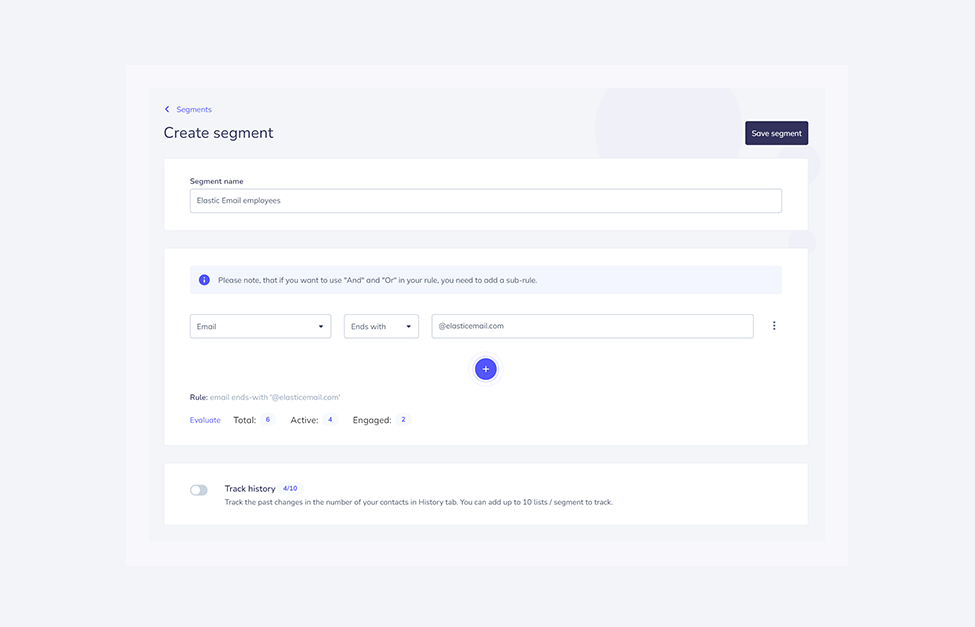
Voila! Now you have a segment ready to send emails only to Elastic Email employees.
Summary
It’s time to start creating new segments based on these tips and rules. Surely, there are some that will suit your business! Afterward, you just need to measure the crucial email marketing metrics and stats to determine which segments are the most effective for you and generate the highest ROAS. It’s always worth testing and exploring new segments and solutions that work.
We trust you'll uncover segments that elevate your ROI and enhance your performance. While it demands increased engagement in your email campaigns, it should prove profitable in the long run. Look forward to experiencing higher engagement rates, better open rates, and an increase in CTR. That's the outcome you should expect from advanced segmentation and personalization.
Key Takeaways
- Understanding your audience and segmenting contact lists are crucial for sending relevant content
- Segmentation involves dividing email contact lists into smaller groups based on specific conditions
- Personalized messages make users feel more valued, leading to a positive mood and potentially a 40% revenue increase for companies with personalized marketing tactics
- Segments work best when combined with automation
- Effective segment ideas include: Engaged subscribers, Win-back emails to re-engage inactive users, Content interest, Upselling and cross-selling offering supplementary products or higher tiers, Abandoned cart, Stage of the sales funnel, Information based on survey, Industry, Revenue, Country, Birthday, Time-zones, Gender, Bargain hunters, Website activity, No purchase for a long time, Specific email providers
- Regularly measure email marketing metrics and stats
- Advanced segmentation and personalization are expected to elevate ROI and enhance performance
Eager to put this knowledge to some use?




